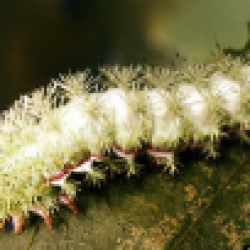Source Institutions
Source Institutions
Add to list Go to activity
Activity link broken? See if it's at the internet archive

In this indoor and outdoor activity, learners discover that insects grow and develop as do all living things, going through a process known as complete metamorphosis. First, learners read the book "The Very Hungry Caterpillar" and discuss how the caterpillar in the story changes. Then they go outside to observe natural areas for insects or signs that insects have fed there. (In winter, you can use insect replicas.) A fun component is using a hula hoop (or piece of knotted string) to show learners their "study area." For younger learners, or in bad weather, substitute an art activity for the outdoor feeding hike/exploration.
- 5 to 10 minutes
- 45 to 60 minutes
- $5 - $10 per group of students
- Ages 4 - 11
- Activity, Field Trip, Lesson/Lesson Plan
- English
Quick Guide
Materials List (per group of students)
- The Very Hungry Caterpillar book by Eric Carle
- Hula hoops (or substitute circles of string)
- Examples of vegetation upon which insects have fed
- Insect replicas (for use in winter)
- Egg cartons (optional)
- Pipe cleaners (optional)
- Markers, crayons or stickers (optional)
Subjects
-
Life Sciences
-
Diversity of Life
- Plants
- Animals
-
Ecology
- Ecosystems
-
Diversity of Life
-
The Nature of Science
-
The Scientific Process
- Asking Questions
- Conducting Investigations
- Communicating Results
-
The Scientific Process
Informal Categories
- Animals
- Arts and Crafts
- Literature
- Model Building
- Nature and Environment
- Outdoor Activity
Audience
To use this activity, learners need to:
- see
- hear
- be mobile
- touch
Learning styles supported:
- Involves teamwork and communication skills
- Involves hands-on or lab activities
Other
Includes alignment to state and/or national standards:
This resource is part of:
Access Rights:
- Free access
By:
- Rogers Huff, Paula
Rights:
- All rights reserved, Board of Regents of the University of Wisconsin System, 2005
